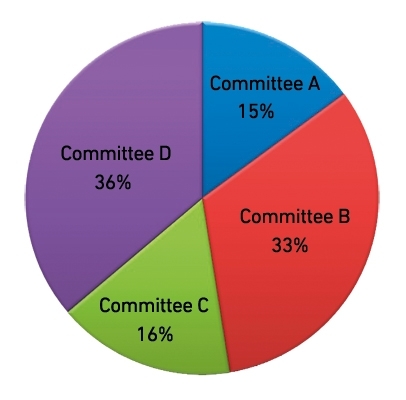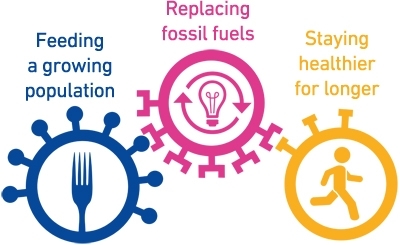Comment: BBSRC funding for microbiology
Issue: What is life?
10 May 2016 article

Biotechnology and Biological Sciences Research Council (BBSRC) invests in world-class bioscience research and training on behalf of the UK public. Our aim is to further scientific knowledge, to promote economic growth, wealth and job creation and to improve quality of life in the UK and beyond.
Funded by Government, and with an annual budget of around £509m in 2014–2015 (£459m on research and capital grants, and £50.5m for training and fellowships), we support research and training in universities and strategically funded institutes. BBSRC research and the people we fund are helping society to meet major challenges, including food security, green energy and supporting people to have healthier, longer lives. Our investments underpin important UK economic sectors, such as farming, food, industrial biotechnology and pharmaceuticals.

Despite my past research life which involved the manipulation and characterisation of bacterial enzymes, I could not profess to call myself a microbiologist. However, one of the attractive aspects of working for a funding agency is the exposure we get to an exciting range of novel research.
In 2015, I led a review of the entire BBSRC microbiology portfolio, covering the period 2008–2014. One of the interesting aspects that arose was the cross-cutting nature of microbiology, and how pervasive it is across the BBSRC portfolio. It might be the scientist in me but I must admit to a liking for in-depth portfolio analysis – looking for patterns and trends in the data, and reading a range of exciting grant proposals from across our portfolio.
There was a combination of drivers for this analysis: it is a key research area for BBSRC; the community had raised some concerns about the balance of our portfolio; and no cross-cutting analysis of microbiology had been undertaken for almost eight years. What the analyses revealed was a positive surprise both for me and the expert group that reviewed the analyses, which also allows us to dispel some myths.

Firstly some data: BBSRC’s microbiology portfolio over the last six years accounted for over 30% of our research portfolio, with spend consistently averaging over £80m per year. This consisted of over 2,100 grants to almost 100 institutions. This spend has also been on the increase since 2012.
So what were the pleasant surprises? Well, for one we seemed to fund a broad range of research across kingdoms: predominantly bacteria (47%), viruses (20%) and fungi (17%), with understandably smaller (but multi-million) annual investment in protista (3%), archaea (1%) and ‘other’ (1%), a classification which covers the range of species that the then President of the Microbiology Society described as species where the ‘classification is still under debate’. The breadth of this portfolio continued across model species, and microbes that interact with animal, human or plant systems.
So one of the myths I would like to dispel is the type of research BBSRC supports. I have heard comments that we only support basic microbiology in model systems or that we are only interested in applied microbiology. Well, in keeping with our strategic priorities, which cover both areas, the good news is we invest in the continuum of microbiology research, from fundamental discovery science, through to more translational and applied areas. This is also reflected in the sources of funding, which include ~40% funding through the Responsive Mode mechanism, and the rest is split pretty evenly between initiatives and institute programmes.
One of the strengths of the microbiology community is that their research spans all four BBSRC Responsive Mode Committees, depending on the nature of the research question. The downside of this is that any individual committee member only has visibility of a subset of the microbiology grants we fund. I think this has, in part, led to some of the misconceptions about our portfolio; one committee member who reviewed the portfolio apologised to me for being ‘grumpy’ about microbiology investments when he saw how much was funded through the other committees and mechanisms.
Another myth I was pleased to dispel was around success rates. The data demonstrated that microbiology does better than the average success rates in three out of four committees, and better than average overall. I think there is an inherent frustration from applicants when grant proposals are unsuccessful, and with 20–25% success rates that is most applicants, most of the time. But I can reassure the microbiology community that they do well in our Responsive Mode system.

There were also a number of pleasing trends in the portfolio; we have been investing in an increasing level of human gut and skin microbiome research; the use of industrial schemes has doubled in the last six years too (12% of the microbiology portfolio). We also identified many new exciting impacts from the research we have invested in.
We often find ourselves discussing with the community how we handle interdisciplinary proposals. An RCUK-wide agreement ensures all Responsive Mode research proposals have a home, and where proposals have elements in other councils’ remits, co-funding is often provided. There was no evidence from the portfolio of an issue in this regard; and there are lots of positive examples of Research Councils working together such as the new AMR programme.
Though the BBSRC microbiology portfolio is very healthy there are some areas where we need to do more work in partnership with the community. Plant virology and research on animal fungal pathogens form relatively small parts of the portfolio – there is a need to encourage the next generation of researchers into these fields – and levels of funding on foodborne pathogens has been falling at a time when Defra and the Food Standards Agency funding has also reduced. BBSRC is currently discussing these issues through our various advisory structures. I would note if anyone is interested in joining a BBSRC panel or committee, our annual call for new members opens in May.
ACKNOWLEDGEMENTS
This analysis fed into an expert working group chaired by Professor Sarah Gurr, and I would like to thank all the participants for their time and consideration on this.
ADAM STAINES
Head of Strategy (joint): Agriculture and Food Security, BBSRC
[email protected]
For more information about BBSRC, our science and our impact see the BBSRC website.
To note: ‘microbiology’ is defined by investments containing a substantial component investigating the microbes themselves, i.e. excluding microbes just being used as a research tool.
Image: All BBSRC..
